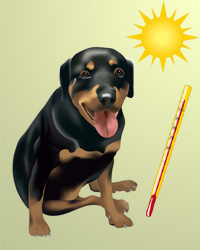Now that the warm weather is upon us with, heat stroke is something that all dog owners should pay serious attention to. Following is an article that addresses this potentially fatal illlness. The disease is described along with its causes, treatment, and prevention.
What is heat stroke?
Heat stroke is a term commonly used for hyperthermia or elevated body temperature. Generally speaking, if a pet's body temperature exceeds 103°F (39.4°C), it is considered abnormal or hyperthermic. Body temperatures above 106°F (41°F) without previous signs of illness are most commonly associated with exposure to excessive external or environmental heat and are often referred to as heat stroke. The critical temperature where multiple organ failure and impending death occurs is around 107°F to 109°F (41.2°C to 42.7°C).
What causes heat stroke?
One of the most common cause of heat stroke or hyperthermia is leaving a dog in a car with inadequate ventilation. The dog's body temperature in this situation can elevate very rapidly, often within minutes. Obviously, keeping windows open will provide enough ventilation to slow the onset of overheating considerably. But leaving a dog unattended in a hot stationary car is a bad idea - open windows or not. Overheating can occur quickly in moderately to severely hot weather.
"Their primary way of regulating body temperature is by panting."
 |
It is important to remember that dogs cannot control their body temperature by sweating as humans do, since they only have a relatively small number of sweat glands located in their
footpads. Their primary way of regulating body temperature is by panting.
Other common causes of heat stroke include being left in a yard without access to shade or water on a hot day, being exposed to a hair dryer for an extended period of time, and excessive or vigorous exercise during hot temperatures. Excited or excessively exercised dogs are sometimes at risk even if the environmental temperature and humidity does not appear hot. This is particularly true if they are kept in a poorly ventilated environment or dog house. Dogs with a restricted airway such as the brachycephalic breeds (flat faced dogs such as pugs, boxers and bulldogs) are at greater risk. In these breeds, clinical signs of heat stroke can occur when the outside temperature and humidity are only mildly or moderately elevated. |
These dogs, with their flat faces, narrow nasal passages, and fleshy pallates, exert much mor energy breathing and panting than other dogs do. Similarly, dogs that are muzzled for any reason can be at greater risk to develop hyperthermia since their ability to pant is restricted by the muzzle.
Any infection causing fever (pyrexia) can lead to hyperthermia. Seizures or severe muscle spasms can also elevate the body temperature due to the increase in muscular activity.
What are the signs of heat stroke ?
Sudden energy loss, excessive thirst, collapse, excessive panting, decreased alertness, and excessive salivation are some of the obvious clinical signs of developing heat stroke. Of course, if you are aware that your dog has just recently been expsed to prolonged or intense heat, you will be more likely to associate these changes with the heat. Other common signs often seen are vomiting, wretching, and diarrhoea, sometimes with blood if the reaction is severe.
How can heat stroke be prevented ?
Once the clinical signs mentioned above are present, it is too late to prevent heat stroke
( but not too late to save your dog, see treatment below!). There are some reasonable steps you can take during the warm weather to help prevent this serious illness from afflicting your dog.
As mentioned above, avoid poorly ventilated rooms and enclosures when it is hot out. As far as exercise goes, common sense must prevail. The hotter it is outside, the shorter the period of exercise
should be. Similarly the more strenuous the exercise, the shorter the time frame should be. Another crucial point in avoiding heat stroke is keeping your dog hydrated with water. Access to fresh
drinking water before, during, and after exposure to heat is essential. Just as with people, drinking a lot of water only after you become hot and thirsty following strenuous
exercise is too late. So before you set off on anything from a long walk to a short jog with your dog in hot weather, offer water before you leave the house. Additionally, briing water with you that
you can give during the trip. And make sure to again pour fresh water in the bowl when you get back!
 What is the treatment for heat
stroke?
What is the treatment for heat
stroke?
Hyperthermia is an immediate medical emergency. Safe, controlled reduction of body temperature is a 
priority. Cool water (not cold) may be poured over the head, stomach, armpits and feet, or soaking wet cool towels may be applied to these areas. Rubbing alcohol may be applied to the
footpads to dilate pores and increase perspiration. Ice may be placed around the mouth and anus. The dog's rectal temperature should be monitored and treatment discontinued once the pet shows signs
of recovery or the temperature has fallen to 103ºF (39.4ºC). A common mistake that people make is to continue to take measure to lower the temperature until it is normal. Once you stop cooling the
body down, temperature will continue to drop for at least several degrees. So if you cool the body down until it is normal (100-101 degrees F), body temperature will continue to fall downanother 2-3
degrees. The temperature might end up at 97 degrees, and then you have the opposite problem - hypothermia!!
So again, take the above cooling measures right away, but stop at about 103 degrees.
If your dog is clearly sick and sluggish, and or shows some of the clinical signs mentioned above, you should immediately bring him or her in to the veterinary clinic for further treatment. This may
involve intravenous fluids, oxygen therapy, and mild sedatives, among other things. Bloodwork is often warranted at this stage to check for effects on organs such as the kidneys.
What is the prognosis for heat stroke?
"The prognosis depends on how high the body temperature is elevated, how long the hyperthermia persists, and what the physical condition of the pet was prior to the heat stroke."
The prognosis depends on how high the body temperature is elevated, how long the hyperthermia persists, and what the physical condition of the pet was prior to the heat stroke. If the body temperature did not become extremely high, most healthy pets will recover quickly if they are treated immediately. Some pets may experience permanent organ damage or may die at a later date from complications that developed secondarily to the hyperthermia. Pets that experience hyperthermia are at greater risk for subsequent heat stroke due to damage to the thermoregulatory center.



